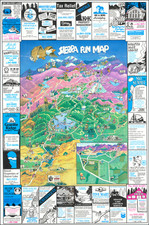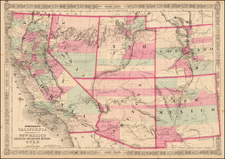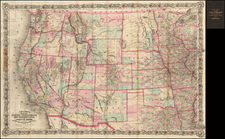Detailed map centered on Sequoia National Park, published by the Department of the Interior.
Shows Rivers, Roads, Contour Lines, Lakes, Meadows, Flats, Canyons, Mountains, Forests and other details. Extends north to the South Fork of the King's River.
Sequoia National Park is the second-oldest national park in the United States. It was established on Septemer 25, 1890 to protect the Big Trees in Giant Forest, including the General Sherman Tree, the world's largest living thing. Sequoia also contains the Mineral King Valley and Mt. Whitney, the highest mountain in the U.S. outside of Alaska.
A small portion of what is now Kings Canyon was originally set aside in 1890 as General Grant National Park. In 1940, General Grant was absorbed into the new and larger Kings Canyon National Park which eventually grew to include the South Fork of the Kings River and 456,552 acres of backcountry wilderness. Managed as one park, together Sequoia and Kings Canyon total over 863,700 acres.
In 1806, Spaniard Gabriel Moraga was the first European to lead an expedition to Kings Canyon, discovering and naming the Kings River in honor of the Three Wise Men. In 1827, trappers and explorers began to trickle through the lofty passes and deep valleys on each side of the Sierra. The gold rush of 1849 drew thousands of outsiders to California, searching for mineral wealth and beginning the exploration of the mountains.
People first started coming to the sequoia forests in large numbers shortly after the end of the Civil War. The General Grant Tree was discovered in 1862 by Joseph Hardin Thomas and named in 1867 by Lucretia Baker. Five years later, on March 1, 1872, Ulysses Grant, now president of the United States, signed the bill designating Yellowstone as the world's first national park.
In 1864, a scientific exploration to map and identify major geographic features led to the naming of Mt. Whitney, the highest peak in the park. In 1873, John Muir, the famous naturalist, visited Kings Canyon - which impressed him with its similarity to the terrain of Yosemite Valley. In 1877, Muir climbed to Converse Basin, six miles north of Grant's Grove and discovered a sawmill established to process lumber from the sequoia groves. He found that the mills had cut down every mature tree but one in the basin, prompting a strong lobbying effort to save the trees. Fueled by Muir's lobbying efforts and editorials in the Visalia Delta newspaper, President Benjamin Harrison signed a bill in 1890 that established Sequoia National Park as California's first national park and protected it from further logging. It is the second national park, preceded only by Yellowstone.











![[Early Landsat Photocomposite of California]](https://storage.googleapis.com/raremaps/img/small/90468.jpg)


